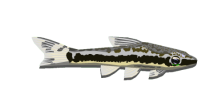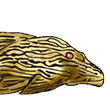Tail shape in fry
-
gedtranter
- Posts: 60
- Joined: 26 May 2006, 14:26
- I've donated: $25.00!
- My images: 1
- My cats species list: 3 (i:0, k:0)
- My aquaria list: 1 (i:1)
- Spotted: 1
- Location 2: Brisbane, Australia
Tail shape in fry
I've successfully raised some trilineatus fry recently and noticed on a couple of the ones I lost after raising them to about 4/5 weeks, the lower lobe of the caudal fin was folded up towards the upper lobe, almost as if it were missing entirely (but it wasn't). The appearance of this seemed to be the death knell for the fish as they went downhill afterwards. I neither raised nor lost a lot, maybe it was just coincidence in a few of the ones I did lose.
Is this to be filed in the '... just one of those things' section or am I missing something else?
On the fry tank - bare bottom 20l, pH 7, 27C, 50% water change (from the main tank) & syphoning daily.
Is this to be filed in the '... just one of those things' section or am I missing something else?
On the fry tank - bare bottom 20l, pH 7, 27C, 50% water change (from the main tank) & syphoning daily.
- kim m
- Posts: 610
- Joined: 13 Nov 2004, 00:07
- My cats species list: 49 (i:0, k:0)
- Location 1: Denmark
- Interests: Pike and Carpfishing, Aquariums (mainly corys)
I had a problem with fin-deformities (pelvicfins was under-developed) in some species when raising the fry in bare-bottom tanks. I was wondering if it was a genetic deformity, but when raising fry from tha same parent fish on sand bottom, I had very, very few of these cases compared to the fry raisen on bare bottom.
Perhaps you should try raising the next batch on sand to see if this could be a solution?
Could be other things as well (nitrite etc.), but this was not the problem in my case.
Perhaps you should try raising the next batch on sand to see if this could be a solution?
Could be other things as well (nitrite etc.), but this was not the problem in my case.
Best regards,
Kim M
-----------
Catfish Study Group
Guardians of Catfish
Skive Akvarieforening
Kim M
-----------
Catfish Study Group
Guardians of Catfish
Skive Akvarieforening
-
gedtranter
- Posts: 60
- Joined: 26 May 2006, 14:26
- I've donated: $25.00!
- My images: 1
- My cats species list: 3 (i:0, k:0)
- My aquaria list: 1 (i:1)
- Spotted: 1
- Location 2: Brisbane, Australia
Ammonia and nitrite are both unreadable and nitrate is usually around 10/15. As I said, the numbers affected were too small to draw any real conclusions probably. I might give a sand bottom a go.
How do you manage to get rid of uneaten food and keep the sand clean in a small raising tank? I imagine syphoning uneaten food would take all the sand with it.
How do you manage to get rid of uneaten food and keep the sand clean in a small raising tank? I imagine syphoning uneaten food would take all the sand with it.
-
gedtranter
- Posts: 60
- Joined: 26 May 2006, 14:26
- I've donated: $25.00!
- My images: 1
- My cats species list: 3 (i:0, k:0)
- My aquaria list: 1 (i:1)
- Spotted: 1
- Location 2: Brisbane, Australia
- apistomaster
- Posts: 4735
- Joined: 10 Jun 2006, 14:26
- I've donated: $90.00!
- My articles: 1
- My cats species list: 12 (i:0, k:0)
- My Wishlist: 1
- Location 1: Clarkston, WA, USA
- Location 2: Clarkston, WA, USA
- Interests: Aquaculture and flyfishing
Just a very thin layer of fine sand, less than 1/2 inch thick gives the same results as a thicker substrate and retains most of the easy to keep clean features of a thicker substrate. I think Corys benefit from a more natural substrate. A variety of microfauna developes in the substrate that may help provide a more balanced diet for developing fry. It may be that some deformities are manifestations of a vitamin deficiency. Vitamin enriching the foods may help, also.
I have noticed that Apistogramma fry grow better if they have a little fine sand to sift rather than a bare bottom.
I have noticed that Apistogramma fry grow better if they have a little fine sand to sift rather than a bare bottom.
Avid Trout fly fisherman. ·´¯`·...¸><)))º>
- apistomaster
- Posts: 4735
- Joined: 10 Jun 2006, 14:26
- I've donated: $90.00!
- My articles: 1
- My cats species list: 12 (i:0, k:0)
- My Wishlist: 1
- Location 1: Clarkston, WA, USA
- Location 2: Clarkston, WA, USA
- Interests: Aquaculture and flyfishing
I just took my own advice and just added a very thin layer to the bottom of two 20 gal L containing Corydoras sterbai fry that are 4 to 7 days free swimming.
Then, for good measure, I gravel vacuumed out 1 liter of bug ridden subtrate sludge of my cherry shrimp breeding colony tank and added 1/2 l. to each tank. The shrimp tank is crawling with thousands of copepods. Under the microscope there is also a diverse population of bristleworms,nematodes, rotifers and protozoans.
The spawning tanks had been set up as sterile as possible to reduce egg fungus and snails that might eat the eggs. I added a bunch of Najas guadelupensis that grows well natant.
I have found that once the fry are free swimming that it improves their survival if there is a more complex ecology in which the fry can develop.
Then, for good measure, I gravel vacuumed out 1 liter of bug ridden subtrate sludge of my cherry shrimp breeding colony tank and added 1/2 l. to each tank. The shrimp tank is crawling with thousands of copepods. Under the microscope there is also a diverse population of bristleworms,nematodes, rotifers and protozoans.
The spawning tanks had been set up as sterile as possible to reduce egg fungus and snails that might eat the eggs. I added a bunch of Najas guadelupensis that grows well natant.
I have found that once the fry are free swimming that it improves their survival if there is a more complex ecology in which the fry can develop.
Avid Trout fly fisherman. ·´¯`·...¸><)))º>
- mona o
- Posts: 74
- Joined: 21 Jun 2006, 21:53
- Location 1: NORWAY
- Location 2: Norway, near Oslo
- Interests: All Corydoras, but also the small tetras like Hyphessobrycon amandae
When raising Cory fry, it's important to keep their entire enviroment clean. This includes the tank bottom itself. I'm not talking about just siphoning and changing the water, but keeping the inside of the tank itself very clean.
Washing it in very hot water will kill any bad bacteria.
When raising my Cory fry, I'm alternating between to identical plastic tanks. Every second or third day, I give the fry a new, clean and scrubbed tank.
This prevents that dangerous build-up of harmful bacteria layer on the bare bottom. An almost invisible, slimy and thin film covering the bottom. No soap is used, only very hot water, and I'm using a large clump of ordinary white filter wadding/filter wool to scrub it thouroughly. It takes a minute or two, and it's worth the effort. This keeps the fry healthy and strong and gives you a high survival rate.
Washing it in very hot water will kill any bad bacteria.
When raising my Cory fry, I'm alternating between to identical plastic tanks. Every second or third day, I give the fry a new, clean and scrubbed tank.
This prevents that dangerous build-up of harmful bacteria layer on the bare bottom. An almost invisible, slimy and thin film covering the bottom. No soap is used, only very hot water, and I'm using a large clump of ordinary white filter wadding/filter wool to scrub it thouroughly. It takes a minute or two, and it's worth the effort. This keeps the fry healthy and strong and gives you a high survival rate.
- apistomaster
- Posts: 4735
- Joined: 10 Jun 2006, 14:26
- I've donated: $90.00!
- My articles: 1
- My cats species list: 12 (i:0, k:0)
- My Wishlist: 1
- Location 1: Clarkston, WA, USA
- Location 2: Clarkston, WA, USA
- Interests: Aquaculture and flyfishing
Sounds like you use smaller tanks than I do if they are plastic. I raise Corys in 12x12x30 inch tanks holding 20 US gallons each. I find that small tanks are too much trouble and besides, I raise many hundreds of Corydoras fry at any particular time and reasonable routine maintenance is sufficient. This is a small commercial operation I run so I'm going for large numbers of fish becoming availabe for sale on a routine basis.
Avid Trout fly fisherman. ·´¯`·...¸><)))º>
- mona o
- Posts: 74
- Joined: 21 Jun 2006, 21:53
- Location 1: NORWAY
- Location 2: Norway, near Oslo
- Interests: All Corydoras, but also the small tetras like Hyphessobrycon amandae
My answer was for "gedtranter", the topic starter in this thread  (not meant as a comment to your post, sorry)
(not meant as a comment to your post, sorry)
apistomaster wrote:Sounds like you use smaller tanks than I do if they are plastic. I raise Corys in 12x12x30 inch tanks holding 20 US gallons each. I find that small tanks are too much trouble and besides, I raise many hundreds of Corydoras fry at any particular time and reasonable routine maintenance is sufficient. This is a small commercial operation I run so I'm going for large numbers of fish becoming availabe for sale on a routine basis.
-
gedtranter
- Posts: 60
- Joined: 26 May 2006, 14:26
- I've donated: $25.00!
- My images: 1
- My cats species list: 3 (i:0, k:0)
- My aquaria list: 1 (i:1)
- Spotted: 1
- Location 2: Brisbane, Australia
Thanks for that Mona. It is difficult for me to say what works and what doesn't work as my cory spawnings have been a rather ad hoc event. Since they started spawning it has been a fairly regular occurance albeit in my South American planted community set-up. I save what eggs I can from the others and don't fancy chasing the corys with a net so have to put up with v.low numbers of 'saved' eggs. I only have one rearing tank at the moment so can't mix newly hatched fry with older ones either.
Furthermore I'm going overseas on holiday in four weeks and have nobody I can trust with my young fish so I've stopped trying to save any new eggs for the moment. Summer is on it's way in Brisbane, so I think they may stop spawning as the water warms up.
I'll store your suggestions and apisto's until I am in a position to properly try them out.
Furthermore I'm going overseas on holiday in four weeks and have nobody I can trust with my young fish so I've stopped trying to save any new eggs for the moment. Summer is on it's way in Brisbane, so I think they may stop spawning as the water warms up.
I'll store your suggestions and apisto's until I am in a position to properly try them out.




